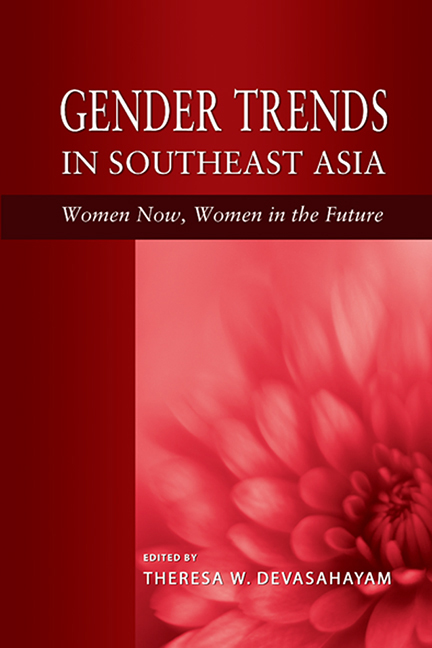Book contents
- Frontmatter
- Contents
- Contributors
- List of Tables and Figures
- Foreword
- Message
- Acknowledgements
- 1 Introduction: Women in Southeast Asia: Changes and Continuities
- 2 Women, Marriage and Family in Southeast Asia
- 3 Gender Trends in Migration and Employment in Southeast Asia
- 4 Has Gender Analysis been Mainstreamed in the Study of Southeast Asian Politics?
- 5 Gender Mainstreaming in Health: Mainstream or “Off-Stream”?
- 6 Politicization of Islam in Indonesia and Malaysia: Women's Rights and Inter-Religious Relations
- Index
5 - Gender Mainstreaming in Health: Mainstream or “Off-Stream”?
Published online by Cambridge University Press: 21 October 2015
- Frontmatter
- Contents
- Contributors
- List of Tables and Figures
- Foreword
- Message
- Acknowledgements
- 1 Introduction: Women in Southeast Asia: Changes and Continuities
- 2 Women, Marriage and Family in Southeast Asia
- 3 Gender Trends in Migration and Employment in Southeast Asia
- 4 Has Gender Analysis been Mainstreamed in the Study of Southeast Asian Politics?
- 5 Gender Mainstreaming in Health: Mainstream or “Off-Stream”?
- 6 Politicization of Islam in Indonesia and Malaysia: Women's Rights and Inter-Religious Relations
- Index
Summary
INTRODUCTION
The evolution from the WID (Women in Development) approach to the GAD (Gender and Development) approach brought the political language of the feminist discourse to the forefront of discussions in the international development agenda. It was argued that putting on the gender lens would result in a clearer, more realistic view of the conditions and the position of women and men in society. In the area of health, the GAD approach helped to widen the perspective on development, as health issues became included as integral to a country's development. Locating the issues within the gender framework was seen as a way of finding answers as to why gender inequality and inequity exists. The adoption of the word “gender” which replaced “women” is seen as a step forward in gender mainstreaming. Moser and Moser (2005, p. 11) in their paper reviewing the success and limitations of gender mainstreaming since Beijing have evaluated the progress on gender mainstreaming in three stages:
• adopting the terminology of gender equality and gender mainstreaming;
• putting gender mainstreaming policies into place; and,
• implementing gender mainstreaming.
These stages will be assessed in this chapter in an effort to map the various components of gender mainstreaming policy in health specifically in the contexts of Cambodia, Malaysia, the Philippines, and Vietnam.
The ‘buy-in’ to the idea that tackling gender inequality is critical to development led governments across the world to accept gender mainstreaming as a strategy to achieve gender equality and the empowerment of women. International organizations, donors, United Nations (UN) agencies and nongovernment organizations (NGOs) have assisted many countries with financial and technical assistance and capacity building to facilitate structural changes. Gender specialists and gender focal points were “located within a centralized team, as well as ‘embedded’ in decentralized departmental and regional offices” (Moser and Moser 2005, p. 14). Manuals, toolkits and checklists were also developed. Given the range of initiatives to ensure gender mainstreaming, one would have imagined that the literature would be rich with success stories and best practices.
- Type
- Chapter
- Information
- Gender Trends in Southeast AsiaWomen Now, Women in the Future, pp. 73 - 94Publisher: ISEAS–Yusof Ishak InstitutePrint publication year: 2009



